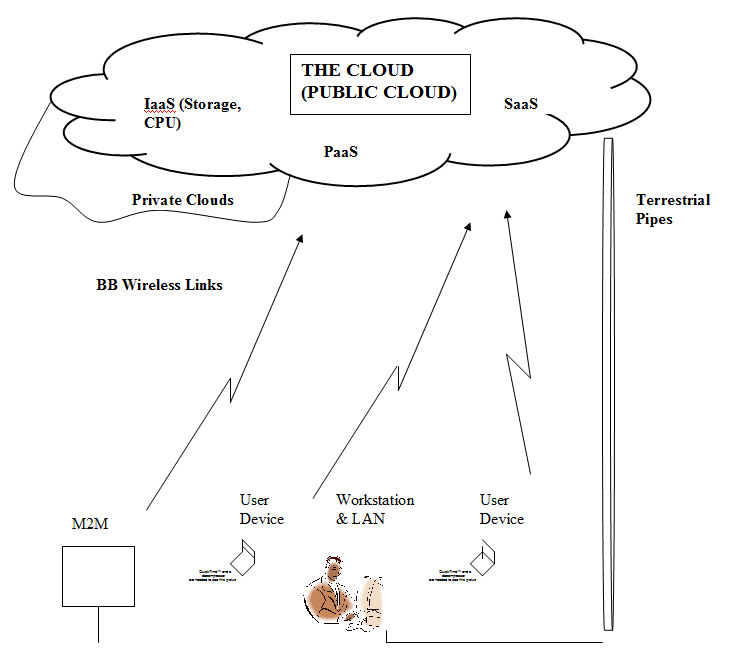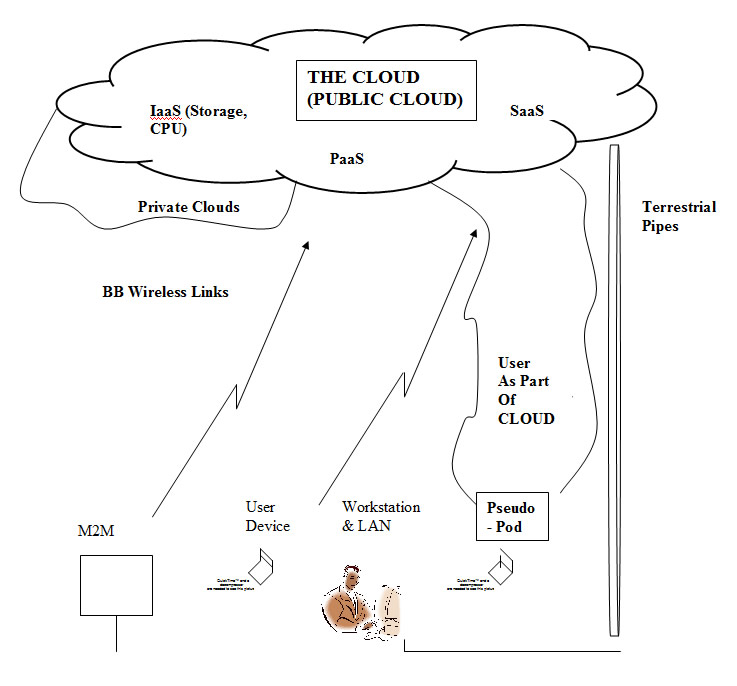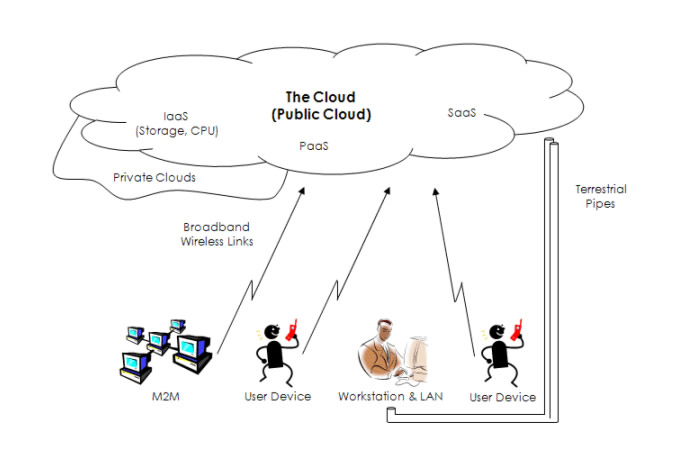Visually the Cloud is represented in Figure 1. Figure 1 is focused on the wireless side of the Cloud, with the terrestrial connections represented by a single pipe on the right side. This current depiction also describes a multilayered computing cloud consisting of public and private networks, storage, CPUs, apps, software as a service (SaaS and software platforms, PaaS).
[lightbox type=”image” src=”https://www.mobilecloudera.com/wp-content/uploads/2013/02/Users-Pic-1.jpg”] [/lightbox]
[/lightbox]
In order to reduce the complexity of the diagram one of the things not shown is the interconnection between these cloud elements, which also exists. As will be discussed later, one of the augmenting factors in explaining the intensity of usage with cloud computing is the often uncounted interactions between these cloud elements
It is not unusual for a given mobile application or a given software as a service application to not only have a link to the initiating user device but also to require sessions and messaging with other elements of the cloud such as other applications i.e. GIS (geographic information systems), augmented reality, synchronization software etc. therefore involving not only other apps but also even other SaaSs and also other CPU, storage and even simple routing resources. Looking at the overall interactions of all elements of this computing cloud one realizes that being able to determine volumes of traffic is not a simple task but a complex one beginning with the application the user is trying to undertake in the broadest sense.
In the Figure, the wireless traffic is coming from (left to right): M2M (machine-to-machine) part of the Baseload of traffic (not requiring user actions) on the network. A figure is shown with a wireless device; another is shown using a workstation and a wireless LAN; a third figure is shown to the right with an additional wireless device.
As we project the future of the Mobile Cloud, a critical aspect of its evolution lies with the device evolution and the related evolution of software on those devices. The following table presents a simplified device evolution picture based on the CPU capabilities noted in cycle times from megahertz to GHz.
Increase In Mobile Device CPU Capabilities Pre-2000-2015
(Cycle Times)
[table]
| Pre-2000 (MHz) | 2006 (MHz) | 2008 (MHz) | 2010 (MHz) | 2015 (GHz) |
|---|---|---|---|---|
| <100 | iPhone 600 | iPhone 3.0 – 600 | iPhone 4S 800 ………..(1000) | 1.5-2.2 (2-4 cores) |
| Samsung 1000 | Samsung 1500 | |||
| Motor. 1000 | Motor. 1200 (Bionic) |
[/table]
Fundamentally, we’re seeing the dumb handheld exhibited by the pre-2000 under 100 kilohertz CPUs to of course today’s 1GHz-plus standard model for all of the major handset providers and the expected progression to essentially the Snapdragon-plus and Nvidia Tegra models which not only have lower power consumption and longer battery life but are also are in the 1.5 GHz range with multiple core capability.
This massive increase in device computing power, juxtaposed with the vast growth of smartphones and the ever-diminishing price curves for better performance, lead into another dramatic development which we foresee, the evolution of the cloud encompassing not just centralized computing services and assets (IaaS) but essentially encompassing the users’ computing assets as well.
Figure 2 is almost identical to Figure 1 except for the almost “pseudopod” extension of the cloud to include the user or user community or workstation activity on the right side. As is happening today with various client architectures, which have part of the overall computing requirements done in the device and with the extensive growth of the device capabilities which is identified in table above, it is clear that part of the cloud will come to include the user community.
[lightbox type=”image” src=”https://www.mobilecloudera.com/wp-content/uploads/2013/02/Users-Pic-2.jpg”] [/lightbox]
[/lightbox]
In many ways the cloud and the user are one and the world faces a future of not just tens or hundreds of thousands of major data center elements in the computing cloud as in Figure 1 but actually the potential for there to be elements of hundreds of millions of computers in the cloud, which are both part of the cloud and using the cloud. This is a situation of the cloud folding in on itself.
The great difference in the sustainability of this view of the future, in contrast to the past worlds of distributed computing, is, first, one of scale. The past world of distributed computing was a world of terminal devices/ laptops and towers for 100’s of millions at best, tethered to the world’s terrestrial networks coverage. The world of tomorrow is one of smart, personal devices, with you 24 hours a day, virtually everywhere and counted not just in billions but with M2M eventually in the tens of billions. The only service solution to meet this market would be a “dispersed” one.
The other great difference is, one of type and economics, based on the evolution of the device’s intelligence, equal to the smartest laptops of yesteryear, at a radically lower cost, permitting intelligence to be out there: dispersed.
[lightbox src=”https://www.mobilecloudera.com/wp-content/uploads/2013/02/Users-Pic-3.jpg”] [/lightbox]
[/lightbox]
